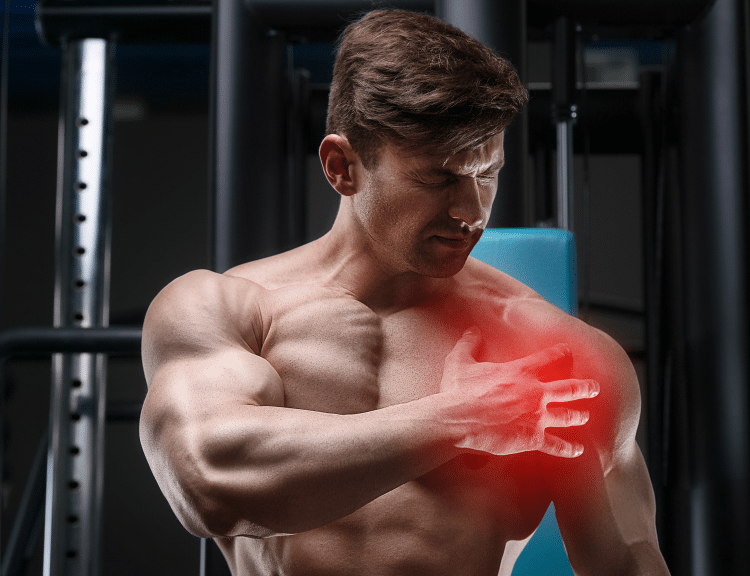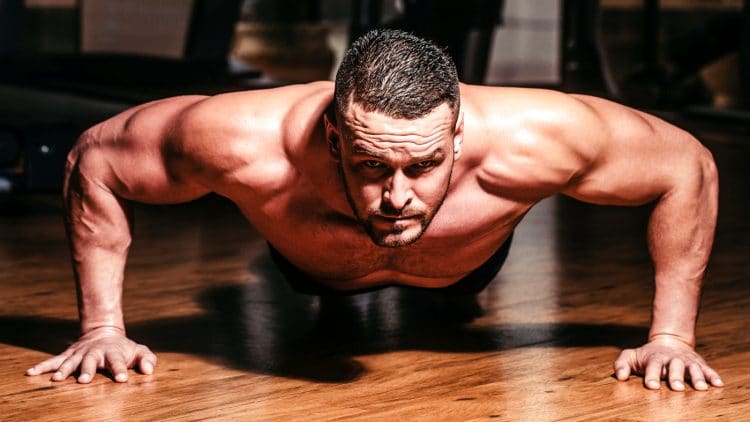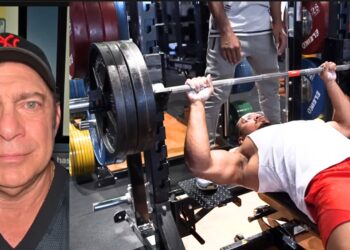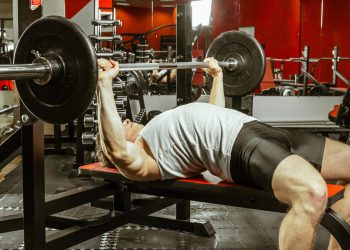The barbell bench press is considered by many lifters to be the best exercise for building chest size and strength. Go to any gym, especially on a Monday, and you’ll probably see a bunch of guys paying their dues at the bench press station.
But while the bench press is a productive exercise for many people, there are times and situations when it may not be your best choice.
In this article, we reveal the ten best non-bench exercises you can use to build a bigger, more muscular chest.
Reasons to Stop Bench Pressing
Now, before you start sending us hate mail for suggesting that you stop bench pressing, it’s important to stress that, for some lifters, the bench press is a great exercise. In fact, for many, it’s the best way to develop upper body muscle mass and strength.
Bodybuilders throughout history have used the bench press to build picture-perfect pecs, and who are we to tell you to quit the world’s favorite exercise?
But, the reality is that a small but meaningful percentage of exercisers get very little from the bench press, and it may even be more problematic than beneficial. For those poor souls, the bench press is nothing but a waste of time and could even be dangerous. This article is for them!
Level Up Your Fitness: Join our 💪 strong community in Fitness Volt Newsletter. Get daily inspiration, expert-backed workouts, nutrition tips, the latest in strength sports, and the support you need to reach your goals. Subscribe for free!
So, if you can bench press safely and it’s producing the results you want, keep doing it. As the saying goes, if it ain’t broke, don’t fix it. But, if you feel let down by the bench press or simply cannot do it, the good news is there are plenty of alternatives you can use instead.
Reasons not to bench press include:
Shoulder pain
If you’ve got long arms, narrow shoulders, and/or a shallow chest, you may feel the bench press more in your joints than your pecs. Bench presses are a leading cause of shoulder pain.
Not an effective chest exercise
While the bench press is a good muscle builder for some people, it may be less effective for others. In other words, you may be a bench press non-responder.
No equipment/spotter
Needless to say, if you want to bench press, you’ll need a barbell, a bench, and if you are planning on training to failure or lifting heavy weights, a spotter, too. You may not have access to all these things if you train at home or in a poorly equipped facility, e.g., a hotel gym.
Lack of workout variety
If your chest workout always starts with bench presses, you could soon find yourself stuck in a training rut. If your progress has stalled, sticking with the same exercises and workout won’t help get you unstuck. It’s time to drop the bench press from your program and try some new exercises.
Exercise enjoyment
Believe it or not, some people simply do not like doing bench presses! While the bench press is beloved by many exercisers, others find it intimidating, uncomfortable, or otherwise unpleasant. The good news is that the bench press is not compulsory, and you don’t have to do it if you don’t want to.
Non-functional
How many times in real life have you found yourself lying on your back with a weight across your chest and then had to push that weight up using just your arms? It’s not something that many people ever have to do!
The bench press has very little functional carryover to activities outside of the gym. For example, if you are training for sport, life in the military, or otherwise want to develop functional strength, the bench press may not be the best upper body exercise for you.
The Best Non-Bench Press Moves for A Bigger Chest
Whatever your reason for not bench pressing, these are the ten best non-bench press moves to do instead. Each one works your chest in a similar way but is also different enough to provide a real alternative to bench pressing.
1. Floor Press
The floor press is sometimes seen as the poor man’s bench press, but rather than being a low-tech make-do, it’s actually a bonafide contender to the bench press. The floor press is easier on your shoulders than the bench press and also stops you from bouncing the bar off your chest, so it’s a safer, stricter exercise.
You can do floor presses with a barbell, dumbbells, or kettlebells. You can also do it unilaterally, i.e., one-handed. Whether you train in a gym or at home, this is an excellent alternative to bench presses.
Read all about floor presses in our in-depth guide.
2. Push-ups
Many lifters are quick to dismiss the humble push-up in favor of bench presses. But, rather than being an exercise best left to beginners, the push-up is actually a very effective chest builder that deserves a place in even advanced exercisers’ programs.
Push-ups involve a very similar movement to bench presses, but you need to use your core to stabilize your midsection, and your shoulders are free to move naturally because they aren’t restricted by a bench. This makes them more joint-friendly and more functional.
However, push-ups will lose some of their muscle-building properties once you can bang out sets of 20-30 reps or more. High-rep sets are not the best use of your training time. However, there are plenty of ways to make push-ups harder to boost their effectiveness.
More intense push-up variations include:
- Deficit push-ups (hands raised to increase the range of motion)
- Decline push-ups (feet raised to put more weight on your arms)
- Weighted vest push-ups
- Resistance band push-ups
- 1 ½ rep push-ups (to increase time under tension)
- Paused push-ups (to increase time under tension)
- Plyo/clap push-ups
Read more about these and other high-intensity push-up variations in this detailed article.
3. Close Grip Dumbbell Bench Press
Close grip dumbbell bench presses are a shoulder-friendly alternative to barbell bench presses. With this exercise, you press your dumbbells together AND upward, which increases pec activation. As a result, you can get an intense pec workout while using relatively light weights.
Level Up Your Fitness: Join our 💪 strong community in Fitness Volt Newsletter. Get daily inspiration, expert-backed workouts, nutrition tips, the latest in strength sports, and the support you need to reach your goals. Subscribe for free!
You can do close grip dumbbell bench presses on a flat, incline, or decline bench to hit your mid, upper, or lower chest, respectively. You can also do this exercise while lying on the floor, i.e., close grip dumbbell floor presses.
How to do it:
- Sit on an exercise bench with a dumbbell in each hand. Using a neutral grip, place and press the dumbbells together. Pull your shoulders down and back, and brace your abs.
- Lie flat on the bench and hold the dumbbells on your chest. Press the weights inward as hard as you can. Tuck your upper arms into your sides.
- Push the weights up and over your chest until your arms are straight but not locked. Keep the tension on your pecs by continuing to press the weights together.
- Lower the dumbbells to your chest and repeat.
- Do not ease up on the inward pressure; keep pushing the dumbbells together for the entire duration of your set.
4. Gironda Chest Dip
Vince Gironda, known as the Iron Guru, was a golden-era bodybuilding coach. He HATED the bench press so much that he banned it from his Hollywood gym. Instead, he favored the neck or guillotine press, which he believed was a superior chest exercise. Gironda was also a fan of dips and tended to use them more than any other chest exercise.
The Gironda chest dip is quite different from the type of dip that most lifters are familiar with. Still, it’s a very effective chest exercise and a viable alternative to barbell bench presses.
How to do it:
- Use dipping bars that are wider than shoulder-width apart. The narrower your grip, the less chest engagement there will be.
- Place your hands on the bars with your palms turned inward. Support your weight on straight arms.
- Bend your legs forward, so your body is in a piked position. Tuck your chin down and into your chest.
- Bend your arms and descend as far as possible without hurting your shoulders. Get a good stretch in your pecs. Allow your upper arms and elbows to flare outward.
- Extend your elbows and push yourself upward, stopping just short of lockout to keep the tension on your pecs. Push inward as well as downward to maximize pec engagement.
- Descend and repeat.
5. Dumbbell Fly and Press Superset
Bench pressing invariably involves lifting heavy weights. However, lifting heavy weights does not guarantee that you’ll build bigger pecs. In fact, if you go too heavy, you may find yourself cheating the weight and taking work away from the target muscles.
The dumbbell fly-press combo uses light to moderate weights and combines two exercises to provide more muscle tension. This is the ideal exercise for home lifters who only have access to lighter dumbbells.
How to do it:
- Using a flat, incline, or decline bench, lie down with a dumbbell in each hand. Press the weights up to arms’ length, palms turned inward. Bend your elbows slightly, and then keep them rigid.
- Open your arms and lower the weights out and down to get a good stretch in your pecs. Do not hyperextend your shoulders.
- Squeeze the dumbbells back up and together. Repeat for the desired number of reps, e.g., 10-12.
- Without pausing, bend your arms and lower the dumbbells down to your shoulders. Press them back up. Repeat for the desired number of reps, e.g., 10-12 reps.
- Or, if you prefer, you can alternate between these two exercises, i.e., one flye and one press.
6. Standing Svend Press
No one knows who Svend is or was, but this exercise is named after them! The standing Svend press involves squeezing a weight plate between the palms of your hands to engage your pecs. This is one of the only standing freeweight chest exercises you can do.
However, it’s worth mentioning that by doing this exercise standing, your deltoids end up working just as hard as your pecs. If this bothers you, check out the following exercise – the supine Svend press – which is more chest-centric.
How to do it:
- With your arms bent, press two five or ten-pound weight plates together in front of your chest.
- Push the plates away from you until your arms are straight. Simultaneously press your arms inward, squeezing the plates together.
- Bend your arms and pull the plates back toward your chest, and repeat for the desired number of reps.
- You can also do this exercise using a single weight plate. However, that tends to deemphasize the need to push your hands together.
7. Supine Svend Press
This exercise is a cross between regular Svend presses and close-grip dumbbell bench presses. It’s a great move for anyone who only has very limited training equipment available. You can do this exercise lying on a bench or on the floor – a supine Svend floor press.
How to do it:
- Lie on your back and press a weight plate vertically between the palms of your hands.
- Starting with the edge of the plate touching your chest, push the weight up to arms’ length while maintaining inward pressure.
- Lower the plate back to your chest and repeat.
8. Stability Ball Dumbbell Press
Most people are familiar with stability balls and use them for abs exercises like crunches and sit-ups. A few may even branch out and do stability ball squats or push-ups. However, a good-quality stability ball is also a great alternative to an exercise bench, making it ideal for dumbbell bench presses.
The ball moves slightly beneath you, creating instability and increasing muscle activation. In addition, which no bench pinning your shoulders in place, your scapulae are free to move, making this a very shoulder-friendly exercise.
Using a ball also means you can transition between flat, decline, and incline dumbbell presses just by changing the angle of your body.
However, before doing stability ball dumbbell bench presses, ensure your ball is properly inflated and free from cuts and nicks, so it doesn’t deflate unexpectedly.
How to do it:
- Sit on your stability ball with a dumbbell in each hand. Rest the end of the weights on your thighs with your palms facing inward.
- Walk your feet forward and lean back until the ball is behind your shoulders and your hips and shoulders form a straight line. Your shins should be vertical.
- As you lean back, flex your arms and position the dumbbells in front of your shoulders. Rotate your hands into an overhand grip if required.
- With your core braced, press the weights up to arms’ length and then lower them again. Repeat for the desired number of reps.
- On completion, with the weights on your shoulders, walk your feet back in and sit up to return to the upright starting position.
9. Cable Crossover
Cable crossovers are often viewed as a pec-shaping exercise. However, the reality is that crossovers can also be an effective and shoulder-friendly muscle builder. With cable crossovers, you can take your shoulders through an extensive but comfortable range of movement, and your scapulae are free to move naturally. Also, you can adjust the angle of your arms to hit your upper, mid, or lower chest as required.
While you won’t build massive strength with cable crossovers, it’s still a very useful chest hypertrophy exercise.
Read all about cable crossovers in our in-depth guide.
10. Chest Press Machine
A lot of fitness experts are very against the use of machines, stating that they’re non-functional and reduce stabilizer activation. And while those guys are perfectly correct, these are not bad things when you are training for hypertrophy or muscle size.
Reducing stabilizer recruitment means you’re free to focus on working your pecs to failure and won’t have to worry about smaller muscles bringing your set to a premature end. Plus, you can also do pump-inducing drop sets more easily with a machine.
So, before you dismiss machine exercises entirely, remember that they are a very useful hypertrophy tool and a valid alternative to barbell bench presses.
Learn more about machine chest presses here.
Non-Bench Press Moves – Wrapping Up
While it may seem blasphemous to suggest that the bench press is not all it’s cracked up to be, there is no escaping that, for some, the bench press is not the best chest builder.
Whether you’ve got long arms, a shallow chest, narrow shoulders, or iffy joints, set after set of bench presses could be a waste of your valuable training time. Or maybe you train at home and don’t have space for a barbell and bench press station.
Regardless of the reasons why, it’s good to know that you don’t HAVE to bench press to build the pecs of your dreams. In fact, before the 1940s, the bench press was virtually unheard of. However, despite this, the bodybuilders of the day still managed to develop impressive pecs.
So, if you love to bench press and it works for you, there is no reason not to keep at it. But, if you are a bench press non-responder, or simply want an alternative, feel free to replace it with any of the ten exercises outlined above.










